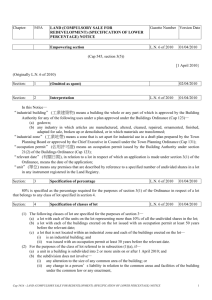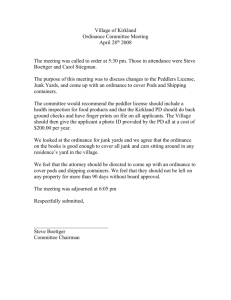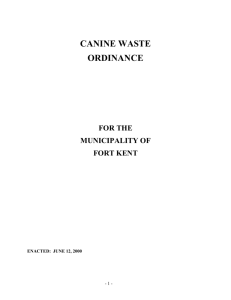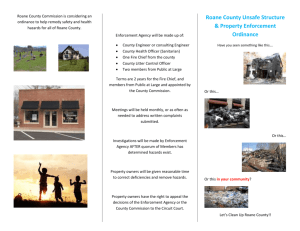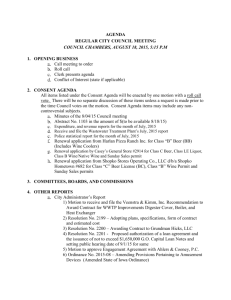Appendix B
advertisement
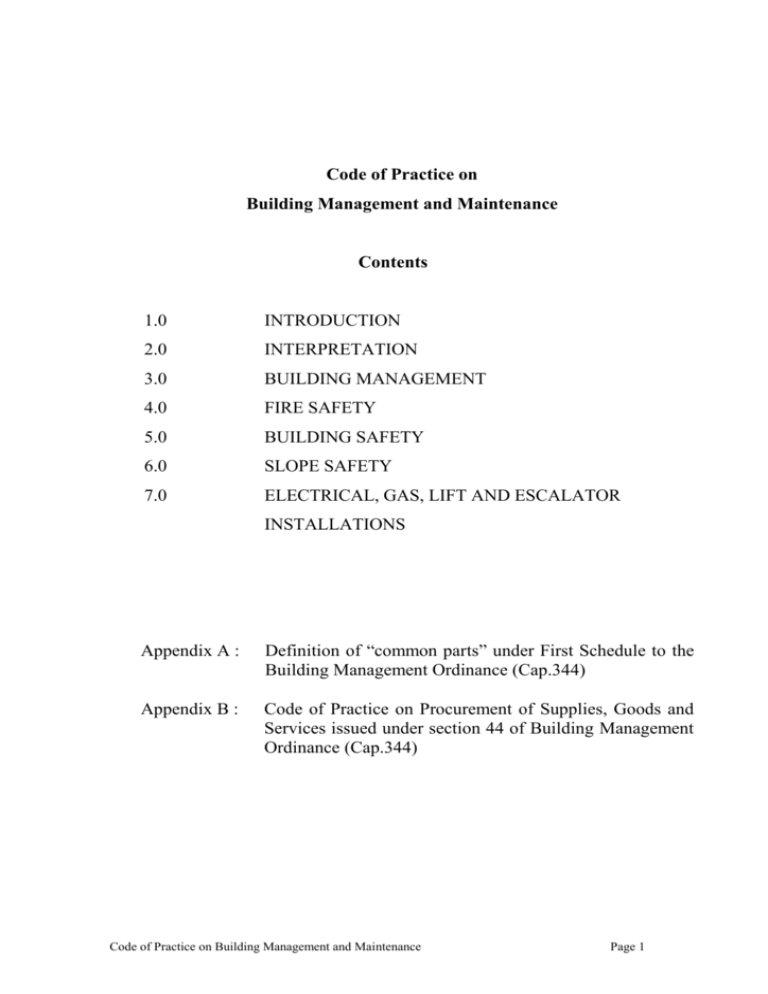
Code of Practice on Building Management and Maintenance Contents 1.0 INTRODUCTION 2.0 INTERPRETATION 3.0 BUILDING MANAGEMENT 4.0 FIRE SAFETY 5.0 BUILDING SAFETY 6.0 SLOPE SAFETY 7.0 ELECTRICAL, GAS, LIFT AND ESCALATOR INSTALLATIONS Appendix A : Definition of “common parts” under First Schedule to the Building Management Ordinance (Cap.344) Appendix B : Code of Practice on Procurement of Supplies, Goods and Services issued under section 44 of Building Management Ordinance (Cap.344) Code of Practice on Building Management and Maintenance Page 1 1.0 INTRODUCTION 1.1 General This Code of Practice on Building Management and Maintenance (the Code) is issued by the Secretary for Home Affairs, as the Authority under the Building Management Ordinance (Cap.344), under section 44(1)(b) of the Ordinance. 1.2 Purpose of the Code The purpose of the Code is to publicize standards of management and maintenance of the common parts of buildings for compliance by owners, office-bearers of management committee of owners’ corporations (OCs), office-bearers of owners’ committees, managers, building managing agents, management companies and such other persons/bodies charged with the duty to manage the common parts of buildings. The Code itself will have no direct enforcement effect. If OC or owners fail to meet the standards stipulated in this Code, they will not be subject to any criminal proceedings under the Ordinance but such failure may, in any proceeding whether civil or criminal, be relied upon as tending to establish or to negative any liability which is in question in those proceedings. Failure to comply with the Code may result in the Authority issuing an order under section 40B of the Ordinance subjecting the building to mandatory building management. 1.3 2.0 The Building Management Ordinance (Cap.344) The purpose of the Building Management Ordinance is to facilitate the incorporation of owners of flats in buildings or groups of buildings, to provide for the management of buildings or groups of buildings and for matters incidental thereto or connected therewith. INTERPRETATION For the purpose of this Code, unless otherwise stated, “Authority” means the Secretary for Home Affairs; “common parts” means – (a) the whole of a building, except such parts as have been specified or designated in an instrument registered in the Land Registry as being for the exclusive use, occupation or enjoyment of an owner; and (b) unless so specified or designated, those parts specified in the First Schedule to the Building Management Ordinance (Cap.344). An extract of the First Schedule is at Appendix A; “owners’ corporation (OC)” means a corporation of owners of building registered in Code of Practice on Building Management and Maintenance Page 2 the Land Registry under section 8 of the Building Management Ordinance (Cap.344); “Ordinance” means the Building Management Ordinance (Cap.344). 3.0 BUILDING MANAGEMENT 3.1 Organization of owners The owners may establish an OC under the Ordinance or an owners’ committee (howsoever named) under the deed of mutual covenant (if any) of the building to manage, control and administer the common parts. 3.1.1 3.1.2 3.2 The OC or owners’ committee so formed may employ a manager, building management agent or management company to carry out the day to day management, control and administration of the common parts on behalf of the owners. Management of common parts 3.2.1 All common parts of a building shall be maintained in a state of good and serviceable repair and clean condition, and in accordance with the deed of mutual covenant of the building (if any). 3.2.2 No person may convert any part of the common parts of a building to his own use or for his own benefit unless such conversion is approved by a resolution of the OC or owners’ committee (if any). Should such conversion involve change in use and/or additional building works, approval from the relevant government departments is required. In this regard, item 5.9 of this Code is relevant. 3.2.3 No person may use or permit to be used the common parts of a building in such a manner as – (i) unreasonably to interfere with the use and enjoyment of those parts by any owner or occupier of the building; or (ii) to cause a nuisance or hazard to any person lawfully in the building. 3.2.4 Regular inspection and maintenance shall be carried out to the building service systems (as listed in paragraphs 3, 6, 9 and 10 of the definition of common parts in Appendix A) to ensure that such systems are in good order and serviceable conditions. Any emergency repair works as may be required to such system shall be attended to promptly. 3.2.5 All common facilities and amenities including recreational and sports facilities shall be maintained in good and serviceable repair and condition and in compliance with the Public Health and Municipal Services Ordinance (Cap.132). Code of Practice on Building Management and Maintenance Page 3 3.3 3.2.6 Any landscaping area shall be maintained in a good and clean condition. 3.2.7 Any lighting installations in the common parts shall be maintained in a state of good and serviceable repair and condition. Environmental hygiene 3.3.1 Refuse, garbage, junks and/or abandoned building material in the common parts shall be collected on a daily basis and transported to a refuse collection point designated for disposal. 3.3.2 All staircases, corridors, lift lobbies, entrance lobbies/halls, passageways, lightwells and any refuse room/chamber including refuse chute and associated facilities shall be cleansed at least once every week. 3.3.3 Any water seepage or pipe leakage found in the common parts shall be rectified as soon as possible and normally within 3 working days. 3.4 Security Any provision of security and guarding services including the employment of security personnel shall comply with the Security and Guarding Services Ordinance (Cap.460). 3.4.1 3.5 Insurance Owners shall take out insurance in respect of any staff employed by them as required by the Employees’ Compensation Ordinance (Cap.282). 3.5.1 3.5.2 3.6 Owners may insure and keep insured the building or any part thereof to the reinstatement value against fire and other risk. Subject to the implementation of the mandatory third party liability insurance provision in the Building Management (Amendment) Ordinance 2000 and the Building Management (Insurance) Regulation, owners’ corporations shall be required to procure third party liability insurance in respect of the building and common area under its management. Accounts 3.6.1 Proper books and records of account and other financial records, including an income and expenditure account and a balance sheet, in relation to the management, control and administration of common parts shall be properly prepared by the management committee of OC, owners’ committee (if any), manager, building managing agent, management company or such other person/body managing the common parts in accordance with the Sixth and Seventh Schedules to the Ordinance. 3.6.2 With the exception of buildings of 50 flats/units or less, the income and expenditure account and balance sheet shall be audited by a qualified accountant annually. For this purpose, garages, carparking spaces or Code of Practice on Building Management and Maintenance Page 4 carports shall not be counted as flats. 3.6.3 Owners may establish and maintain a contingency fund to provide for any expenditure of an unexpected and urgent nature. 3.7 Procurement of supplies, goods and services 3.7.1 The procurement of all supplies, goods and services shall comply with the Code of Practice on Procurement of Supplies, Goods and Services issued by the Authority under section 44 of the Ordinance at Appendix B. 3.8 Water supply 3.8.1 Water pumps, tanks and associated pipeworks shall be maintained in good and serviceable repair and condition. 3.8.2 Water tanks shall be cleansed at least once every six months. 3.9 Communication among owners/occupants 3.9.1 The manager, building managing agent, management company or any other person/body managing the building shall hold regular meetings with the owners and occupants or their representatives with respect to the management, control and administration of common parts. Minutes of meetings shall be prepared and posted at conspicuous places of the building for information of owners and occupants. 3.10 Deed of mutual covenant 3.10.1 A deed of mutual covenant (DMC) is a document registered in the Land Registry which defines the rights, interests and obligations of owners among themselves. 4.0 3.10.2 Owners shall be aware of the terms and conditions of the DMC of their building and shall perform the duties and exercise the rights as stipulated in the DMC. 3.10.3 A copy of the DMC shall be made available for inspection at the management office (if any) and for the making of copies by owners at their expense. A Chinese/English translation of the original DMC shall also be made available for inspection. However, the translation is only intended as an explanatory document and not intended to carry any legal weight over the original DMC. FIRE SAFETY 4.1 Abatement of fire hazards Means of escape shall be free from obstruction. 4.1.1 4.1.2 Gate/door at building entrance and/or rooftop shall be readily opened from within the premises without the use of a key. Code of Practice on Building Management and Maintenance Page 5 4.1.3 Metal gate or roller shutter shall not be installed across means of escape. 4.1.4 Smoke lobby doors shall be in good working condition and properly closed at all times. 4.1.5 Emergency vehicular access shall be free from obstruction. 4.1.6 Fire service installations or equipment provided in buildings shall not be removed or obstructed. 4.1.7 Fire shutters and dampers shall be maintained in good working order. 4.1.8 Fire service installations or equipment provided in buildings shall be maintained in efficient working order at all times. 4.1.9 Fire service installations or equipment shall be inspected by a registered fire service installation contractor at least once every 12 months. Note : (a) The Director of Fire Services may, pursuant to sections 9(1), 9B(1) and 9B(2) of the Fire Services Ordinance (Cap.95), institute fire hazard abatement action or direct prosecution as appropriate against the owner, tenant, occupier or person in charge of the building who fails to comply with any of the requirements as mentioned in 4.1.1 to 4.1.9 above. (b) Pursuant to sections 9(4) and 9C(1) of the Fire Services Ordinance (Cap.95), the Director of Fire Services may further apply to the court to make a “Fire Hazard Order” or a “Removal Order” as appropriate requiring the owner, tenant, occupier or person in charge of the building to abate the fire hazard. 4.2 Storage of dangerous goods 4.2.1 Under section 6 of the Dangerous Goods Ordinance (Cap.295)(a) storage of dangerous goods in excess of exempted quantity shall be licensed and approved by the Director of Fire Services; and (b) dangerous goods shall not be stored in excess of licensed quantity and in unlicensed stores (e.g. common area, open ground). 4.3 Fire Safety Checklist 4.3.1 Owners, occupants, manager, building managing agent, management company, office bearers of OC or owners’ committee, or such other person/body managing the building shall carry out routine inspections on fire safety provisions of their own building and to rectify minor irregularities identified in accordance with the Fire Safety Checklist Code of Practice on Building Management and Maintenance Page 6 published by the Home Affairs Department. 5.0 BUILDING SAFETY Regular building inspection enables timely maintenance and repairs to common building defects. It is advisable for owners or OCs to enlist the service of qualified building professionals (e.g. architect, engineer or surveyor) to assist them in planning and implementing a planned building maintenance programme. Structural repairs shall be carried out under the supervision of an Authorized Person and/or Registered Structural Engineer registered under the Buildings Ordinance (Cap.123). 5.1 Structural elements If there is cracking, spalling, bulging or deformation of structural elements (columns, beams, floor slabs, structural walls and cantilevered balconies/canopies) or exposing of reinforcement bars, the owners or OCs shall appoint an Authorized Person and/or Registered Structural Engineer registered under the Buildings Ordinance to check the condition and, if necessary, submit remedial proposals to the Building Authority, for consideration. 5.1.1 5.2 External walls Minor cracking, damage, spalling or bulging of cement rendering, concrete surface, wall tiles or other finishes and delaminated mosaic tiles shall be repaired, including removing the defective and loose parts. 5.2.1 5.2.2 Minor cracking, damage or spalling in window hoods, sills, fins, architectural features, air-conditioning platform or rusty racks shall be repaired, including removing the defective and loose parts. 5.2.3 Any dampness or water staining marks shall be traced for eliminating the source of dampness. The affected wall finishes shall be repaired, including making good or replacing damaged wall finishes. 5.2.4 Defective protective barriers or railings shall be repaired or replaced. 5.3 Canopies and balconies Canopies and balconies shall not be overloaded and misused. They should be free of all attachments and should not be used for stockpiling. They should be kept in dry condition and properly drained. 5.3.1 5.4 Internal walls 5.4.1 Minor cracking, spalling or bulging of concrete surface, loose plaster or other finishes shall be repaired including removing the defective and loose parts. 5.4.2 Water seepage, staining marks or mould growth on wall surface shall be Code of Practice on Building Management and Maintenance Page 7 rectified. The source of dampness shall be traced and eliminated and the affected wall finishes shall be made good, repaired or replaced. 5.5 Floors and ceilings 5.5.1 Any minor cracking, spalling or bulging of concrete ceiling slabs and loose plaster shall be repaired, including removing the defective and loose parts. 5.5.2 Any water seepage shall be rectified including tracing and eliminating source of dampness and making good, repairing or replacing affected finishes. 5.5.3 Any defective finishes of flooring including hollowness or lifting shall be repaired and made good, including removing the defective parts. 5.6 Roofs/Flat roofs Water ponding on roof/flat roof shall be rectified including repairing the damaged roof/flat roof slab and laying finishes to proper fall. 5.6.1 5.7 5.6.2 In respect of defective water proofing materials and/or movement joints, specialist roofing contractor shall be appointed to rectify the defects, including repairing or replacing defective materials. 5.6.3 Defective roof/flat roof railing, barriers or parapets shall be repaired or replaced. 5.6.4 Roofs/flat roofs shall not be overloaded and misused. They should be free of significant attachments which adversely affect the structure of the building and should not be used for stockpiling. They should be kept in dry condition and properly drained. Windows and doors 5.7.1 Distorted, rusty or defective windows and door frames shall be repaired or replaced. 5.7.2 Any water seepage around window and door openings shall be identified and rectified, including resealing gaps between the frame and wall opening if necessary. 5.7.3 Any defective glazing and lourves, including putty failure, broken/missing of glazing beads and broken glazing, shall be repaired or replaced. 5.7.4 Defective ironmongery including hinges, stays, fasteners, door closers and locks shall be repaired or replaced. 5.8 Drainage The following defects of above-ground drain shall be repaired or rectified Defective pipe fixing 5.8.1 Code of Practice on Building Management and Maintenance Page 8 Rusty pipes Choking and unsanitary condition Vegetation growth 5.8.2 Any choking or unsanitary condition of underground drains shall be cleared or rectified. 5.8.3 Defective manhole covers shall be repaired or replaced. 5.8.4 Cause of any water seepage of pipe ducts shall be established and rectified, including the making good found in loose plaster. For items 5.2 to 5.8, if extensive or major defects are found in the building elements mentioned therein, the owners or OC shall appoint an Authorized Person and/or Registered Structural Engineer registered under the Buildings Ordinance to check the condition and, if necessary, submit remedial proposals to the Building Authority for consideration. For items 5.1 to 5.8, please also refer to general notes 2 to 4 below. 5.9 Unauthorized building works 5.9.1 No unauthorized building works or alteration shall be carried out, or unauthorized structures erected in the common parts. Please also refer to general notes 5 below. 5.10 5.11 Management of smoke stop and fire doors 5.10.1 The doors of the smoke lobby, fireman’s lift lobby, staircase, switch room and rooms containing air-conditioning plant or similar hazardous installations shall be kept in good repair condition including the door hinges, glazed panels and door closers. 5.10.2 These doors shall be kept in closed position. 5.10.3 These doors shall not be removed or replaced with doors having a lower fire resistance such as ordinary glass doors. Management of means of escape 5.11.1 Doors or gates shall not swing out onto exit routes such as the common corridor, staircase and rear lane causing obstruction to the exit routes. 5.11.2 Doors or gates at common parts shall be readily openable from inside without the use of a key. 5.11.3 Doors giving access to the roof of single-staircase building shall be readily openable from inside without the use of a key. 5.11.4 Exhaust fans, air-conditioning units or similar installations shall not be Code of Practice on Building Management and Maintenance Page 9 installed in the smoke lobby or staircase. No opening shall be formed in the smoke lobby or staircase walls for such installations or for doors or windows. 5.12 5.11.5 Exit routes shall be free of any obstruction caused by unauthorized structures such as racks, shelves, cabinets and store rooms. 5.11.6 Adequate lighting shall be provided for the exit routes and shall be kept in good condition. Management of fire resisting construction 5.12.1 The walls of switch rooms and rooms containing air- conditioning plants or similar hazardous installations shall be kept in good condition and free of unprotected openings. 5.12.2 5.13 Electric cables and similar installations in staircases shall be enclosed by fire resisting walls or ducting. Such walls and ducting shall be kept in good condition. Any access panels thereto shall be kept in closed position. Management of access for firefighting and rescue 5.13.1 The walls of fireman’s lift lobby shall be kept in good condition and free of unprotected openings. For items 5.10 to 5.13, please also refer to general notes 4 and 5 below. 5.14 Public telecommunications and broadcasting services installations 5.14.1 Cabling facilities (which include risers, ducts, conduits, cable trays, junction boxes, equipment rooms, etc) located in common parts of the building used for the installation of cables and equipment of public telecommunications and broadcasting services should be maintained in good and serviceable condition and protected against from any risk of fire, flooding and vandalism. 5.14.2 For the provision of access to, and use of the cabling facilities for telecommunications and broadcasting services, the “Guidelines for Property Owners, Developers and Managers for the Provision of Facilities within Property Developments for Access to Public Telecommunications and Broadcasting Services” issued by the Telecommunications Authority in May 1995 and its subsequent revisions should be adhered to. General Notes: 1. The above technical contents are guidelines for building management purpose the compliance of which may not constitute full compliance of other legislation applicable to building and fire safety. Owners and OCs shall seek professional advice on the technical standards and relevant legislation as far as possible. Code of Practice on Building Management and Maintenance Page 10 2. In establishing the need for basic building maintenance and repair works, the extent and location of defects have to be taken into account. Any repair works required shall preferably be carried out by a Registered General Building Contractor registered under the Buildings Ordinance (Cap.123). 3. Where a building is left in a state of disrepair or has been altered to such an extent as to generate concerns on public safety, the Building Authority may initiate enforcement action under the Buildings Ordinance (Cap.123) and order the owners or OCs to carry out investigation, repair or restatement works as necessary. 4. For technical standards relating to means of escape, means of access for firefighting and rescue and fire resisting construction, please refer to the following codes of practices published by the Buildings Department and any subsequent revisions(i) Code of Practice for the Provision of Means of Escape in case of Fire 1996; (ii) Code of Practice for Means of Access for Firefighting and Rescue 1995; or (iii) Code of Practice for Fire Resisting Construction 1996. 5. For standards on reinstatement of buildings or parts thereof affected by unauthorised building works, please refer to the plans approved by the Building Authority and/or the Buildings Ordinance (Cap.123). 6.0 SLOPE SAFETY 6.1 Any slope or retaining wall for which an owner is responsible shall be maintained in a state of good condition in accordance with Geoguide 5 – Guide to Slope Maintenance published by the Geotechnical Engineering Office of the Civil Engineering Department. 7.0 ELECTRICAL, GAS, LIFT AND ESCALATOR INSTALLATIONS 7.1 Any electrical installations, gas installations, lift and escalator at common parts of a building shall be maintained in accordance with the relevant statutory requirements and codes of practice published or approved by the Director of Electrical and Mechanical Services 7.1.1 Electrical installations Electricity Ordinance (Cap.406); Electricity (Registration) Regulations (Cap.406 sub.leg.); Electricity (Wiring) Regulations (Cap.406 sub.leg.);and Code of Practice for the Electricity (Wiring) Regulations. Code of Practice on Building Management and Maintenance Page 11 7.1.2 Gas installations Gas Safety Ordinance (Cap.51); Gas Safety (Gas Supply) Regulations (Cap.51 sub.leg.); Gas Safety (Installation and Use) Regulations (Cap.51 sub.leg.); Gas Safety (Miscellaneous) Regulations (Cap.51 sub.leg.); Gas Safety (Registration of Gas Installers and Gas Contractors) Regulations (Cap.51 sub.leg.); and Code of Practice GU06: LPG Installation for Catering Purposes in Commercial Premises. 7.1.3 Lifts and escalators Lifts and Escalators (Safety) Ordinance (Cap.327); Code of Practice on the Design and Construction of Lifts and Escalators; and Code of Practice on the Examination, Testing and Maintenance of Lifts and Escalators. - End - Code of Practice on Building Management and Maintenance Page 12 Appendix A First Schedule [s. 2] COMMON PARTS 1. 2. 3. 4. 5. 6. 7. 8. 9. 10. 11. 12. 13. 14. 15. External walls and load bearing walls, foundations, columns, beams and other structural supports. Walls enclosing passageways, corridors and staircases. The roofs, chimneys, gables, gutters, lighting conductors, satellite dishes and ancillary equipment, aerials and aerial cables. (Amended 27 of 1993 s. 38) Parapet walls, fences and boundary walls. Vents serving 2 or more flats. (Amended 27 of 1993 s. 42) Water tanks, reservoirs, pumps, wells, sewers, sewage treatment plants, drains, soil pipes, waste pipes, channels, water-courses, gutters, ducts, downpipes, cables, conduits, refuse chutes, hoppers and refuse container chambers. (Amended 27 of 1993 s. 38) Cellars, toilets, water closets, wash houses, bathhouses, kitchens and caretakers' flats. Passageways, corridors, staircases, landings, light wells, staircase window frames and glazing, hatchways, roofways and outlets to the roofs and doors and gates giving access thereto. Lifts, escalators, lift shafts and machinery and apparatus used in connexion therewith and the housing thereof. Lighting apparatus, air conditioning apparatus, central heating apparatus, fire fighting equipment and installations intended for the use and benefit of all of the owners generally and any room or chamber in which such apparatus, equipment or installation is filled or installed. Fixtures situated in a flat which are used in connexion with the enjoyment of any other flat or other portion of the building. Lawns, gardens and playgrounds and any other recreational areas. (Added 27 of 1993 s. 38) Swimming pools, tennis courts, basket-ball courts, squash courts and premises containing or housing any other sporting or recreational facilities. (Added 27 of 1993 s. 38) Clubhouses, gymnasiums, sauna rooms and premises containing health or leisure facilities. (Added 27 of 1993 s. 38) Slopes, gradients and retaining walls including sea walls (if any) comprising or forming part of any land which is in common ownership with the building. (Added 27 of 1993 s. 38) Code of Practice on Building Management and Maintenance Page 13 Appendix B Section 44 of the Building Management Ordinance (Chapter 344) Code of Practice on Procurement of Supplies, Goods and Services It is hereby notified that under section 44 of the Building Management Ordinance, the Authority has issued the following Code of Practice on the procurement of supplies, goods and services: 1. Any supplies, goods or services the value of which exceeds or is likely to exceed(a) the sum of $100,000 or such other sum in substitution therefore as the Authority (Secretary for Home Affairs) may specify by notice in the Gazette; or (b) the sum which is equivalent to 20% of the annual budget of the corporation or such other percentage in substitution therefore as may be approved by the corporation by resolution passed at a general meeting, whichever is the lesser, shall be procured by invitation to tender. 2. Subject to para. 1 above, the management committee shall prepare a proposal setting out the types of supplies of goods or service required, the respective estimated costs and the period open for tender. A copy of the tender proposal shall be displayed at a prominent place of the building. 3. (a) A tender to which para. 1 above applies shall be in writing and be sealed and deposited in a strong double locked box marked ‘Tender-Box (Chinese Version)’ provided for that purpose only and such box shall be securely located at a prominent place in the building. The two keys of the tender-box are to be separately kept by the chairman, secretary or treasurer. (b) Where it is impracticable or difficult to comply with the requirement under para. (a) above, the corporation may, by a resolution passed at a general meeting, accept tenders handed in or sent by post to the Code of Practice on Building Management and Maintenance Page 14 registered office of the corporation. 4. The minimum number of tenders to be sought shall be as follows(a) 3 in the case of tenders for supplies, goods or services exceeding a value of $10,000 but not exceeding a value of $100,000; or (b) 5 in the case of tenders for supplies, goods or services exceeding a value of $100,000. The Authority may specify by notice in the Gazette such other sums in substitution of the above mentioned tender values. 5. The closing date and time for acceptance of tenders shall be clearly stated in the relevant tender documents. Later submissions shall not be accepted. 6. All tenders shall be opened at the same time in the presence of at least 3 members of the management committee who shall sign and date the tender documents. 7. Tenders of a value not exceeding the sums specified under paragraph 8 shall be submitted to the management committee which may accept or reject them. 8. Tenders of a value exceeding(a) the sum of $200,000 or such other sum in substitution therefore as the Authority may specify by notice in the Gazette; or (b) the sum which is equivalent to 45% of the annual budget of the corporation or such other percentage in substitution therefore as any be approved by the corporation by resolution passed at a general meeting, whichever is the lesser shall be submitted to the corporation which may, by a resolution passed at a general meeting of the corporation, accept or reject them. 9. The management committee shall maintain and keep in safe custody for a period being not less than 6 years, as the corporation may determine, all Code of Practice on Building Management and Maintenance Page 15 tender documents, copies of contracts, accounts and invoices and any other documents in the possession of the corporation and relating to the procurement of supplies, goods and services. The management committee shall also permit the Authority, the tenants’ representative, an owner, a registered mortgagee or any other person authorized in writing in that behalf by an owner or registered mortgagee to inspect the relevant documents at any reasonable time. 10. The documents referred to in paragraph 9 shall contain such information as to permit the person inspecting that record to calculate the financial liability (including any future financial liability) of the corporation at the time of inspection. 11. Before the award of tender, a member of the management committee shall disclose in writing to the secretary of the management committee any pecuniary interest that he may have in any tender or contract considered or to be considered by the management committee or the corporation. If the secretary of the management committee has such an interest, he should disclose the same in writing to the chairman of the management committee. A management committee member who has indicated a vested interest in the tender or contract shall abstain from voting in the selection of such tender/contract at a management committee meeting. Home Affairs Department July 1997 - Code of Practice on Building Management and Maintenance Page 16
